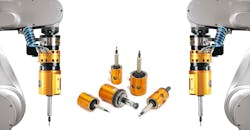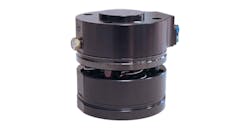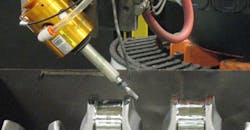IMTS 2016: Compliant Tooling Equipment for Safer Robot Operation
Shiny new robotics technology will be swinging and shifting and buzzing along at manufacturer booths all throughout the nearly 1.3 million sq. ft. of exhibit space at this year’s International Manufacturing Technology Show in Chicago (Sep. 12-17).
And whether robots are veteran workers on your factory floor or merely prospective new hires, ATI Industrial Automation’s Booth #N-6429 is sure to have something for everyone.
The world’s largest supplier of robotic tool changers and deburring tools, as well as force/torque and collision sensors, will show off its latest safety-increasing innovations in those categories and more via live demonstrations with FANUC and KUKA six-axis robots.
Here’s what you can expect to see:
U1 Universal Compliance Compensator (UCC)
The 1.4-lb U1, engineered into the robot arm, allows for flexibility and forgiveness in assembly applications by acting as a shock-absorber, ATI CEO Bob Little says.
He explains its function allows the robot to have more human-like motion, enabling it to grip the work piece even when severely misaligned.
“When you jump up in air, you always bend and flex knees, so you comply with floor when you land, because if you jump in air and remain stiff, that’s a pretty hard blow,” Little explains. “Robots are extremely stiff. If a non-compliant robot is hit, that shockwave goes through the tooling and through the robot. That could end up wrecking the part.”
Because of the UCC, which offers compliance in X-Y lateral, X-Y-Z rotation and z-compression (but not tension), a robot can get bumped and move while the piece stays in place.
How does it work?
“The patented mechanism uses a spherical bearing combined with air and springs that give right amount of engineered compliance,” Little says.
By tweaking the pneumatic pressure that resets the piston, the compliance stiffness is adjustable for varying payloads (max: 11 lb) and different applications, such as automated assembly, bin picking, loading and unloading machines, and robotic finishing.
PLd-Safe Tool Changers
More robots appearing on production lines mean more interaction with human workers. The new breed of friendly-faced collaborative robots with light payloads are intended to work side-by-side with people, but giant tool changers programmed for speed and power still pose considerable risk, especially when human error is always a looming threat.
“Ten years ago, there was no safe zone to exchange the tool,” says Little. “There was a safe area, but operators had the ability to unlock the tool, and we did have some incidents where a tool changer fell on the ground damaging the tooling, sometimes grazing people. It happened because they hit the unlock button. With so many buttons on the pad, sometimes you hit the wrong one.”
ATI is changing removing this threat with the PLd-safe tool changers the company is revealing at IMTS. A pneumatic lock connects the master and tool, preventing inadvertent releases.
“And sensors that work directly with the pneumatic valve in the tool changer guarantee it’s locked and cannot be unlocked accidently,” Little says. “This tool changer will allow for barriers and fences to come down and work around people.”
RC-900 and RC-1040 Radially-Compliant Deburring Tools
Deburring has historically relied on humans moving work pieces into costly automated machines to remove the excess material.
A company pays for the labor, the machining center, and due to the repetitive nature of the tasks, workman’s compensation claims for carpal tunnel and other ergonomics- related injuries.
To combat this, Little says factory floors will move employees around to prevent muscle fatigue and hire temporary contract workers.
“That’s not a good process,” he says. “Quality can shift from person-to-person, and with less experienced workers, there are more chances to make a mistake.”
ATI’s Compliant Deburring Tools reduce the chance of mistakes by featuring “a pneumatically-controlled, articulated design that allows the cutting bit to follow the part profile and compensate for surface irregularities, allowing high feed rates and uniform quality,” Little says.
Robotic deburring tools also save time and money.
“Now the robot can be modified to come to the part, or move around the part, rather than put it into an expensive automated machine,” Little says
The newest models appearing at IMTS 2016, the RC-900 and RC-1040 (the number designation indicating wattage) offer a motors with up to 50% more power than the earlier RC-660. They also increase compliance travel by 10%.
About the Author
John Hitch
Editor, Fleet Maintenance
John Hitch, based out of Cleveland, Ohio, is the editor of Fleet Maintenance, a B2B magazine that addresses the service needs for all commercial vehicle makes and models (Classes 1-8), ranging from shop management strategies to the latest tools to enhance uptime.
He previously wrote about equipment and fleet operations and management for FleetOwner, and prior to that, manufacturing and advanced technology for IndustryWeek and New Equipment Digest. He is an award-winning journalist and former sonar technician aboard a nuclear-powered submarine where he served honorably aboard the fast-attack submarine USS Oklahoma City (SSN-723).



